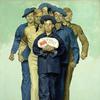TIBET HOUSE US PRESENTS THE MENRIS TRADITION OF TANGKA ART: Paintings by the New Generation in Exile
- NEW YORK, New York
- /
- January 20, 2011
It is with great pleasure that Tibet House US presents an exquisite collection of works in The Menris Tradition of Tangka Art: Paintings by the New Generation in Exile, on display for public viewing from January 20th through March 2nd, 2011. Tibet House US will also present the rare opportunity to purchase the authentic tangka works on display, with prices ranging from $2500 to $8000. All proceeds from sales will go to Tibet House US and the artists.
There will be an opening reception on January 20th from 6pm-8pm.
The exhibition is dedicated to a complex medium unique to Tibetan culture, the Menris tradition of tangka art, which flourished and survived in Tibet for centuries until its interruption by the Chinese Communist invasion in 1950. In 1959, the Venerable Sangye Yeshi fled to India where he sustained the tradition in exile at the personal request of His Holiness the Dalai Lama, founding The Institute of Tibetan Tangka Art (ITTA) in Dharamsala to ensure a high standard of training for future generations of Menris painters. Ven. Yeshi passed away in 2009. However this long and rich tradition continues through his students at ITTA, whose works are on display in this incredible exhibition. Included on display are works by Tashi Dhargyal, who helped Ven. Yeshi found the ITTA.
The Menris tradition is characterized by clear outlines, strong colors, fine shadings and its accentuations in gold. These days, it is rare to see a collection of contemporary, traditional tangkas, as many galleries concentrate on modern arts coming from artists both in and out of exile. This exhibition is a testament to the artists who continue the traditional art of Tibet.
The history of tangka, or scroll paintings, flourished in Tibet due to the nomadic, religious culture of the region where local rulers would travel and hold court in richly appointed tents. The religious order adopted this practice, and monks in great numbers would carry everything with them to set up complete monasteries. Therefore, the tangka format became popular for its ability to easily transport highly decorative and intricate artworks used for spiritual practices.
In addition to completed tangkas, this exhibition includes a set of unfinished works to illustrate the process of tangka creation.
Click here to preview the exhibition: http://www.youtube.com/watch?v=x2-e0eSzp6k
Click here to learn more about The Institute of Tibetan Thangska Art and Ven. Sangye Yeshi’s students: www.tibetanartschool.com
Gallery Location: 22 West 15th Street, New York, NY 10011
Gallery Hours: Monday through Friday from 12 to 5 p.m.
ABOUT TIBET HOUSE US GALLERY
Since opening in 1998, the Tibet House US Gallery has featured exhibitions of classical and contemporary Tibetan art, as well as modern and contemporary art inspired by Tibetan culture. Exhibitions have included artworks from private collections and museums, as well as selections from Tibet House’s own Repatriation Collection. The Repatriation Collection represents an ongoing effort to conserve examples of Tibetan art and artifacts for their eventual repatriation.
The 2,000 square foot Gallery is open to the public and includes a traditional Tibetan shrine room, which is available to visitors for quiet contemplation and meditation.
ABOUT TIBET HOUSE US
Established in 1987 under the auspices of His Holiness the Dalai Lama, Tibet House US is a non-profit educational institution and cultural embassy working to preserve, restore and present Tibet's unique cultural and spiritual heritage by means of a permanent cultural center, with gallery, library, and archives, and developing traveling exhibitions, print publications and media productions. Additionally they seek to share with the world Tibet's practical systems of spiritual philosophy and mind sciences, and its arts of human development, intercultural dialogues, nonviolence, and peacemaking, by means of innovative programs in cooperation with educational and other cultural institutions.




10270x400_c.jpg)

















